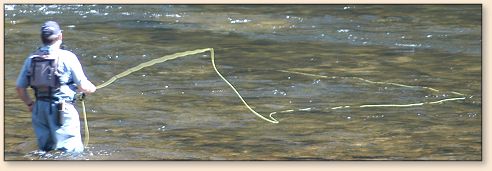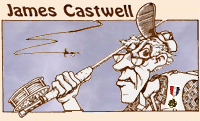|
For those of you just getting started,
here is a secret. You will have a great
time, perhaps catch a few fish and as
time passes, learn a few things. Most
of these you will discover by yourself.
Some may come from books, classes, watching
others fish, but, like I said, mostly you
will be 'self-taught.'
Nothing sticks in a guys head like the
realization that, "Duh, so that's it!"
Probably one of the wonderful things about
fly fishing is the nearly constant learning.
It doesn't matter how long you have been at
it, who you are or who you have become, it
never stops. There are none of us who know
it all. One reason for that is, it's always
changing.
New stuff all the time. Old ideas dusted
off and brought to the forefront. Sometimes
old methods are given new names by some of
the pro's, guru's or writers. Makes life
interesting at the least. There are still
times when I read or learn about some new
little finesse in the game, always humbling
(like, "damn, I did not know that!")
But, here is where I want to take you now.
You are fishing a stream and have made a
cast somewhat upstream. Maybe you are
fishing a dry, perhaps a nymph, doesn't
matter. Here is what you do. You plant your
feet solidly underneath you, look hard at
the water and where you think your fly should
be to catch a fish.
You make the cast and the line runs out, let's
say it is upstream to your left, the fly drops
and the current starts to take your fly and line
sideways to your right. You follow the line with
your rod tip but soon notice that there is a loop of
line on the water going to your right and the tail
of the loop is where your fly is, either floating
or under the surface.
What has happened here is that the fast water
has grabbed your line and is dragging it
downstream. Your fly, wet or dry, is dragging
along behind it. The problem is this, your fly
is going faster than the water now. Actually,
you may have had a good drift of only a few
inches before drag started. Now sometimes this
can work to your advantage, but you really need
to learn to recognize it and how to control it.
And it is so simple once you know what is happening.
And it will always happen.
First, right after the fly has landed, try to
keep your rod low, and do not be afraid to
actually strip in a bit of line. Try to keep
as short and direct line to your fly as
convenient. Then, using mostly the tip of your
rod, throw a little loop of slack upstream as
the fly starts to drift toward you. The amount
will differ if you are going wet or dry. Not too
much if dry, more if you want your fly to drop
without drag. Mending it's called and as you
start using it you will be surprised how much
more you can accomplish. Practice on this will
come naturally. Just watch your fly and if a
dry is leaving a wake, you need to do some
mending. If it's a wet or a nymph, the little
mend or loop of line will get your fly down.

Once it passes you, start to let some slack
into the rod guides and now flip a few little
mends out onto the surface and you can extend
the drift even farther downstream. Time on the
water will bring you up to speed on this, just
knowing what is happening and how to fix it is
all it will take.
"Duh, now why didn't I think of that!" ~ JC
|





